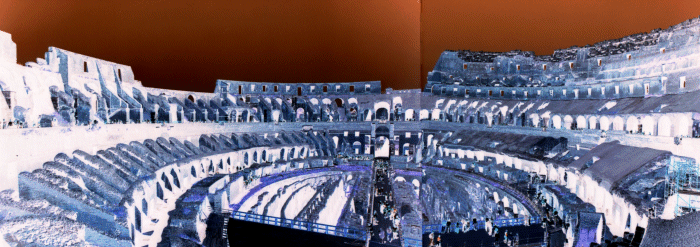
Materials

Different materials were employed for the building of the Colosseum, all of them easily found in the Roman area: travertine limestone quarried from Tibur for the main pillars, the ground floor and the external wall (a road was built for the transport of the stone); tufa for the other pillars, tiles for the floors and the walls, cement for the vaults.
Travertine is a sedimentary stone made essentially of calcite, precipitate from calcareous waters. Its colour is whitish, slightly yellow or reddish. It is used for building, for the floors or as a veneer. It is common in Tuscany, Umbria, Lazio, Marche. The stone can stand a pressure of 226/298 Kg/cmq, according to its quality.
Tufa is a stone produced by the cementing of vulcanic material fallen after eruptions. Its colour is gray, yellowish, greenish or brown. It is used in the preparation of special cements and as a building stone (peperino).
Tiles and bricks were produced with clay mixed with water and often with sand, straw and finely ground pozzolana. The mixture was pressed by hand into a wooden mould, and dried first in the sun. Tiles had to be turned over often, so as that they would not bend. After a long time of drying under cover, tiles were placed in the oven and baked at 800 degrees. The tiles were produced in standard sizes (full and hollow bricks, tiles for roofs etc.). Bricks could be used in wall structures, as roofing and as filling, often by using the leftovers of former works.
Right and bottom: from C.F. Giuliani "L'edilizia nell'antichità"
Cement is a building material with a binding agent, usually produced by mixing finely ground limestone and clay. It reacts to water by forming a cement that hardens to the consistency of stone. Mixed to sand, small stones or pebbles takes the name of concrete aggregate (or beton). Roman cement (today called "malta" in Rome) is composed of calcia and/or pozzolana. Coarse pieces of stone - different qualities of stones according to the use - were added to the cement.
Mortar (malta) is a mix of a binding agent (calcia, cement) and water (malta semplice) or with water and sand (m. composta). It hardens when exposed to air (malta aerea) and also in water (malta idraulica).
Calcia (lime) is a binding substance that Romans produced by baking limestone. The quicklime was converted into lime paste by immersing it in water. By adding water to the lime, Romans produced:
- lime putty thck and greasy; used as a binder for the cement;
- lime milk, with 20/30% of water, used for the paints;
- lime water, clear and disinfectant, used for medical purposes.
Here are some links on Roman engineering and on the materials: